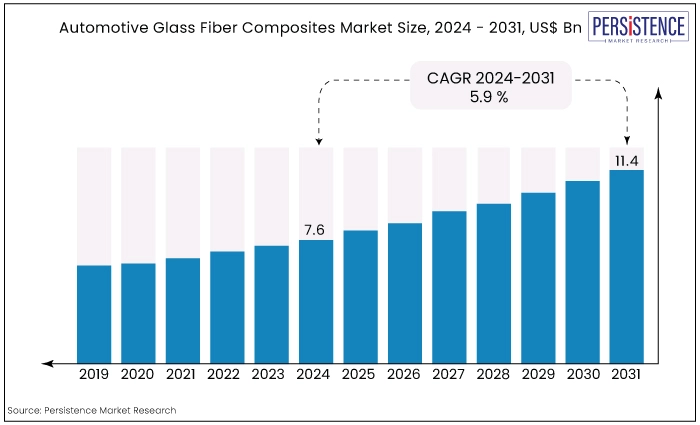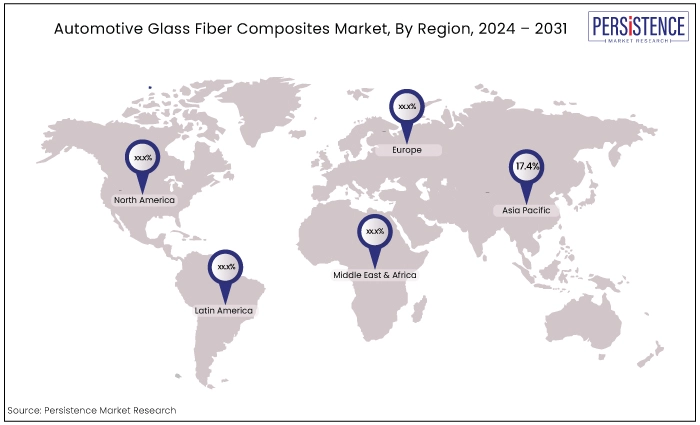Industry: Automotive & Transportation
Published Date: August-2024
Format: PPT*, PDF, EXCEL
Delivery Timelines: Contact Sales
Number of Pages: 180
Report ID: PMRREP34662
The global market for automotive glass fiber composites is estimated to value at US$11.4 Bn by the end of 2031 from US$7.6 Bn recorded in 2024. The market is expected to secure a CAGR of 5.9% in the forthcoming years from 2024 to 2031.
Key Highlights of the Market
|
Market Attributes |
Key Insights |
|
Market Size (2024E) |
US$ 7.6 Bn |
|
Projected Market Value (2031F) |
US$ 11.4 Bn |
|
Global Market Growth Rate (CAGR 2024 to 2031) |
5.9 % |
|
Historical Market Growth Rate (CAGR 2019 to 2023) |
5.2 % |

Asia Pacific Leads the Way, China at the Forefront
|
Region |
CAGR through 2031 |
|
Asia Pacific |
17.4% |
Asia Pacific is expected to experience a high CAGR of 17.4% between 2024 and 2031, having dominated the global automotive composites market in 2024. Because there are so many automakers in China, the country is one of the biggest markets for automotive composites in the Asia Pacific area.
In 2023, China produced the highest number of automobiles—roughly 50%—setting a record. Asia Pacific has a great chance to lead the automotive composite market during the projected period because it is home to many of the world's most well-known automakers.
The need for the product in the area is being driven by the requirement to employ composites in automotive applications due to the need to increase fuel efficiency via the use of lightweight materials.

Demand for Glass Fiber Maximum
|
Category |
Projected CAGR through 2031 |
|
Type - Glass Fiber |
13.7% |
|
Application – Battery Enclosures |
21.8% |
Glass fiber dominates the automotive composites market due to its widespread use in glass fiber reinforced composites, where tiny glass fibers are embedded in plastic polymer resin.
This material choice is favored by automotive composite manufacturers for its cost-effectiveness, stability, high strength-to-weight ratio, lightweight properties, durability, flexibility, and resistance to heat and moisture.
Concurrently, carbon fiber composites are experiencing the fastest growth rate owing to their superior strength and lightweight characteristics, making them increasingly sought-after in high-performance automotive applications.
As automotive industry demands evolve towards lighter, more durable materials that meet stringent performance standards, both glass fiber and carbon fiber composites play pivotal roles in shaping the future of automotive manufacturing.
Battery Enclosures to be the Primary Application Segments
The battery enclosure segment is poised for rapid growth, projected at a CAGR of 21.8% in value, driven by the increasing sales and production of electric vehicles (EVs).
Composites used in battery enclosures offer significant advantages, including a weight reduction of approximately 40% compared to aluminum enclosures. This lighter weight extends the driving range of EVs, enhancing their economic viability and performance.
As automakers prioritize efficiency and sustainability, composite materials enable them to achieve lighter yet robust battery enclosures that meet stringent safety standards.
With the expanding EV market and advancements in composite technology, battery enclosure applications represent a crucial area for innovation and investment in the automotive sector, supporting the transition towards greener and more efficient transportation solutions.
The global automotive industry is undergoing a transformation, emphasizing lightweight materials for enhanced fuel efficiency, performance, and sustainability. Automotive glass fiber composites have emerged as a key solution, offering strength, durability, and reduced weight compared to steel and aluminum.
These composites are increasingly used in various automotive components, including body panels, chassis, interiors, and under-the-hood applications, driving significant advancements in vehicle design and performance.
The primary driver for adopting glass fiber composites is their contribution to overall vehicle weight reduction. Automakers achieve substantial fuel efficiency improvements by using these lightweight materials, meeting regulatory standards and consumer demands for eco-friendly transportation.
Additionally, the inherent strength and stiffness of glass fiber composites enhance vehicle safety by providing better impact resistance and crashworthiness.
Advancements in manufacturing technologies and material formulations have expanded the application scope of glass fiber composites across passenger cars, commercial vehicles, and electric vehicles (EVs). The market for automotive glass fiber composites is thus growing steadily, driven by efforts to enhance vehicle efficiency, safety, and sustainability.
The automotive glass fiber composites market has seen robust growth driven by demand for lightweight materials enhancing vehicle fuel efficiency. Historically, advancements in composite technology have spurred adoption across automotive sectors, including body panels, interiors, and structural components.
The market expansion is bolstered by stringent fuel efficiency standards and increasing preference for electric vehicles, where lightweight materials play a pivotal role.
The market is poised for continued growth with innovations focusing on improving strength-to-weight ratios, durability, and recyclability of glass fiber composites.
Emerging trends include integration of composites in electric vehicle battery housings and structural components, further catalysing market expansion globally.
As automotive manufacturers seek sustainable solutions amidst regulatory pressures, the demand trajectory for glass fiber composites is anticipated to remain upward, driven by their crucial role in achieving light weighting goals and enhancing overall vehicle performance.
Urge for Enhanced Industrial Efficiency
The next ten years should see a robust increase in the worldwide market for automotive composites. The market has seen multiple development prospects unravelled by advancements in the vehicle manufacturing industry.
Car industry preference for automotive composites stems from its superiority over steel competitors. Automotive composites are now a must for suppliers in the sector to boost manufacturing productivity. As such, the automotive composites industry is expected to reach unprecedented heights in the next years on a global scale.
Vehicle Weight Reduction
The need for automotive composites is being driven by two main factors: the need to improve fuel efficiency and reduce vehicle weight through structural improvements, which is becoming urgent.
Automotive composites consisting of aluminum and fiber are in high demand due to an increasing emphasis on design improvements to improve vehicle capabilities. The growing desire from consumers for more fashionable and quick cars is also to blame for this.
One significant element driving demand for automotive composites is the multitude of laws and regulations aimed at lowering carbon emissions in both developed and developing nations. It is anticipated that the market will be further accentuated by automakers' focus on increasing vehicle fuel efficiency.
Expensive Nature of Composite Materials
The automotive composite industry faces significant challenges due to its comparatively high manufacturing costs, which hinder market growth. Factors contributing to this include the expensive raw materials like carbon fibers and thermoplastic resins.
Despite their superior properties compared to traditional materials such as steel and aluminum, these cost barriers limit their widespread adoption beyond the automotive sector. Moreover, the substantial investments required for composite production further restrict their expansion within the automotive industry.
Technological Barriers in Material Development
Technological barriers in material development pose significant challenges for the automotive glass fiber composites market. These barriers include the difficulty in achieving consistent quality and performance of composite materials at scale.
Innovations in material composition and processing techniques require extensive research and development, adding to costs and timelines. Moreover, integrating new composites into existing manufacturing processes and ensuring compatibility with automotive safety standards can be complex.
Additionally, advancements in alternative materials compete for investment and attention, potentially diverting resources away from glass fiber composites.
Addressing these technological barriers is crucial for enhancing the reliability, affordability, and versatility of composites, thereby expanding their application beyond current limitations in the automotive industry.
Integration into Autonomous Vehicles, and Connected Car Technologies
Integration into autonomous vehicles and connected car technologies presents both challenges and opportunities for the automotive glass fiber composites market.
As these technologies advance, there is a growing need for lightweight materials that enhance vehicle efficiency and performance. However, the stringent safety and regulatory requirements associated with autonomous vehicles pose significant hurdles.
Composites must demonstrate exceptional durability, reliability, and crashworthiness to meet these standards, requiring extensive testing and validation.
Moreover, the complex design specifications of connected cars necessitate highly adaptable materials that can integrate seamlessly with sensors, antennas, and other electronic components.
Addressing these challenges presents an opportunity for composite manufacturers to innovate and develop specialized solutions that cater to the unique demands of autonomous and connected vehicles, thereby expanding their market presence in the automotive industry.
Customization and Design Flexibility
Customization and design flexibility in automotive glass fiber composites present challenges due to the need for scalable production processes that can accommodate diverse design requirements efficiently.
Achieving consistent quality and performance across customized composite parts can be technically demanding and may require significant investment in advanced manufacturing capabilities.
Moreover, meeting specific aesthetic and functional demands while maintaining cost-effectiveness poses further challenges. Overcoming these hurdles requires innovative approaches in material development, process optimization, and collaborative partnerships with automotive designers and engineers.
Successfully addressing these challenges will unlock opportunities to cater to varied automotive design preferences and applications, thereby driving growth in the glass fiber composites market.
The competitive landscape of the automotive glass fiber composites market is characterized by a mix of established players and new entrants focusing on technological advancements and strategic partnerships.
Key companies such as Owens Corning, Johns Manville, and Jushi Group dominate with extensive product portfolios and global market presence. Innovation in lightweighting solutions, sustainability initiatives, and integration into electric and autonomous vehicles are key areas of competition.
Strategic alliances for R&D and production capabilities enhancement further shape competition, while regulatory compliance and cost-effectiveness remain crucial factors influencing market dynamics.
Recent Industry Developments
January 2023
Owens Corning launched a new high-performance glass fiber composite designed specifically for automotive applications, enhancing strength and reducing weight compared to traditional materials.
March 2023
Johns Manville announced a collaboration with a major automotive manufacturer to develop advanced glass fiber composites for electric vehicle (EV) battery enclosures, focusing on safety and efficiency.
May 2023
3B Fiberglass and a leading automotive parts supplier formed a partnership to innovate and produce glass fiber composite components for next-generation vehicle models, aiming to improve fuel efficiency and reduce emissions.
June 2023
SGL Carbon introduced a new range of sustainable glass fiber composites, emphasizing recyclability and reduced environmental impact, catering to the growing demand for eco-friendly automotive materials.
|
Attributes |
Details |
|
Forecast Period |
2024 to 2031 |
|
Historical Data Available for |
2019 to 2023 |
|
Market Analysis |
US$ Million for Value |
|
Key Regions Covered |
|
|
Key Market Segments Covered |
|
|
Key Companies Profiled in the Report |
|
|
Report Coverage |
|
|
Customization & Pricing |
Available upon request |
By Type
By Manufacturing Process
By Application
By Vehicle Type
By Region
To know more about delivery timeline for this report Contact Sales
The demand for automotive glass fiber composites is surging due to their lightweight, high strength, fuel efficiency benefits, enhanced safety features, and compliance with stringent environmental regulations, driving their adoption in various vehicle components.
Some of the key players operating in the market are Owens Corning, Johns Manville, Solvay, Orbia, and 3B Fiberglass.
Battery Enclosures segment recorded the significant market share.
A compelling opportunity in the automotive glass fiber composites market is the growing demand for electric vehicles (EVs), driving the need for lightweight, durable materials that enhance battery efficiency and overall vehicle performance and sustainability.
Asia Pacific to account for the significant share in the market.